Hello, everyone. My name is Daichi, an expert providing the information on the radiation issues in an easy-to-understand manner.
Today, I would like to respond to the following questions:
– What kind of wastes are generated through other than decontamination activities?
– What is the Specified Waste?
Table of contents of this article
- What is the Specified Waste?
- The Waste in the Countermeasure Areas
- The Designated Waste
- Summary
I have been involved with the radiation-relevant issues, like the policy on the decontamination activities and the management of the Interim Storage Facility, after the accident of the Fukushima Daiichi Nuclear Power Plant in 2011.
I received a doctorate in the field of radiation, while working in Fukushima.
What is the Specified Waste?
It is elaborated in this article, but decontamination activity is well known as one of the measures for environmental remediation projects at off-site of the Fukushima Daiichi Nuclear Power Plant, after its accident in March 2011.
There are cases, however, in which radioactive waste is generated, as a result of projects other than decontamination activities (please see the following figures).
Amongst the radioactive waste, part of them are defined as the ‘Specified Waste’ and has been treated, based on the Act on Special Measures concerning the Handling of Environment Pollution by Radioactive Materials (in Japanese), which was earlier covered in this article.
Note: the official name of the Act is, ‘The Act on Special Measures concerning the Handling of Environment Pollution by Radioactive Materials Discharged by the NPS Accident Associated with the Tohoku District – Off the Pacific Ocean Earthquake That Occurred on March 11, 2011’.
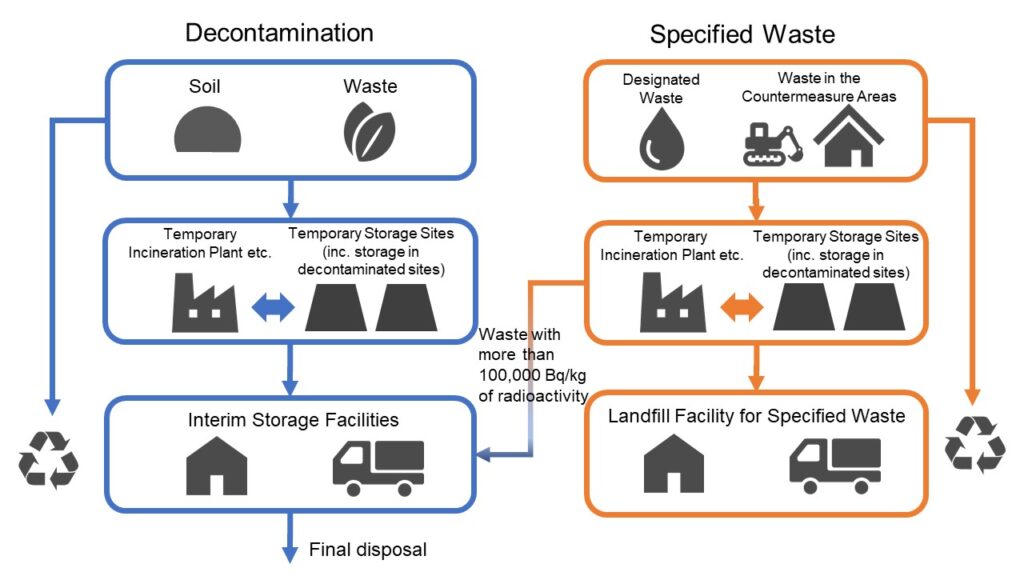
↑ Treatment flow of soil and waste arising from decontamination and other activities in Fukushima Prefecture
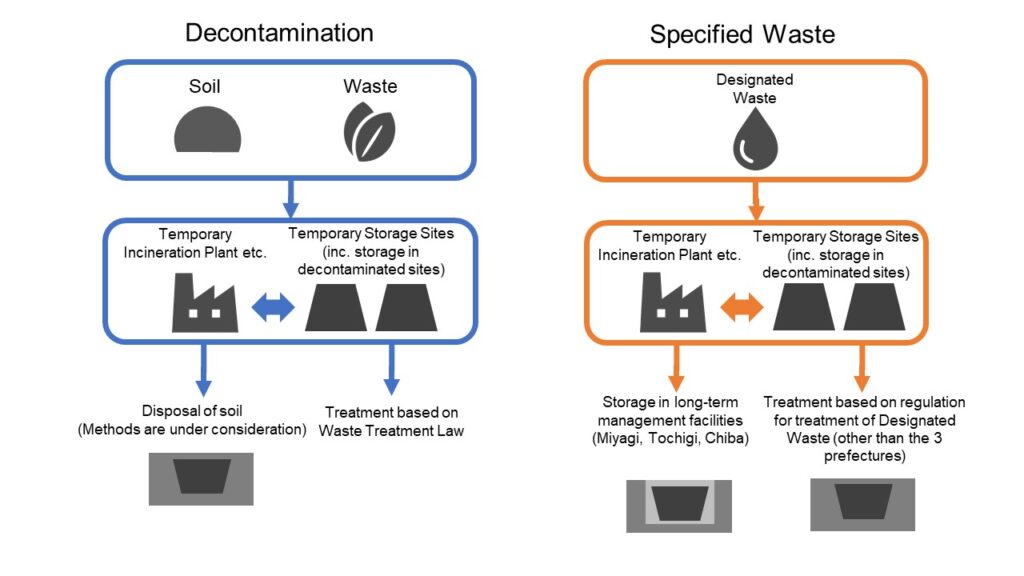
↑ Treatment flow of soil and waste arising from decontamination and other activities in other than Fukushima Prefecture
The Specified Waste is further categorized into the ‘Waste in the Countermeasure Areas’ as well as the ‘Designated Waste’, and has been treated, under the responsibility of the national government.
In the following part of this article, each kind of waste is individually elaborated with specific examples.
The Waste in the Countermeasure Areas
The Waste in the Countermeasure Areas is, as its name represents, the waste generated in the Countermeasure Areas.
The official name of the Countermeasure Areas, is the Countermeasure Areas for the Contaminated Waste.
The areas covered by the Countermeasure Areas is defined in detail in the aforementioned Act on Special Measures concerning the Handling of Environment Pollution by Radioactive Materials, but you can understand the exact areas with the figure in this website (in Japanese).
Actually, the ‘Countermeasure Areas for the Contaminated Waste’ is identical to the Special Decontamination Areas, covered in this article.
As is the case with the Special Decontamination Areas, taking account of the fact that local municipalities were forced to evacuate due to the evacuation order, as well as the social responsibility of the national government, which has promoted the nuclear policy, treatment of the Waste in the Countermeasure Areas has been implemented by the national government.
So, let’s look at the specific kinds of the Waste in the Countermeasure Areas in the following parts.
Waste generated by Tsunami
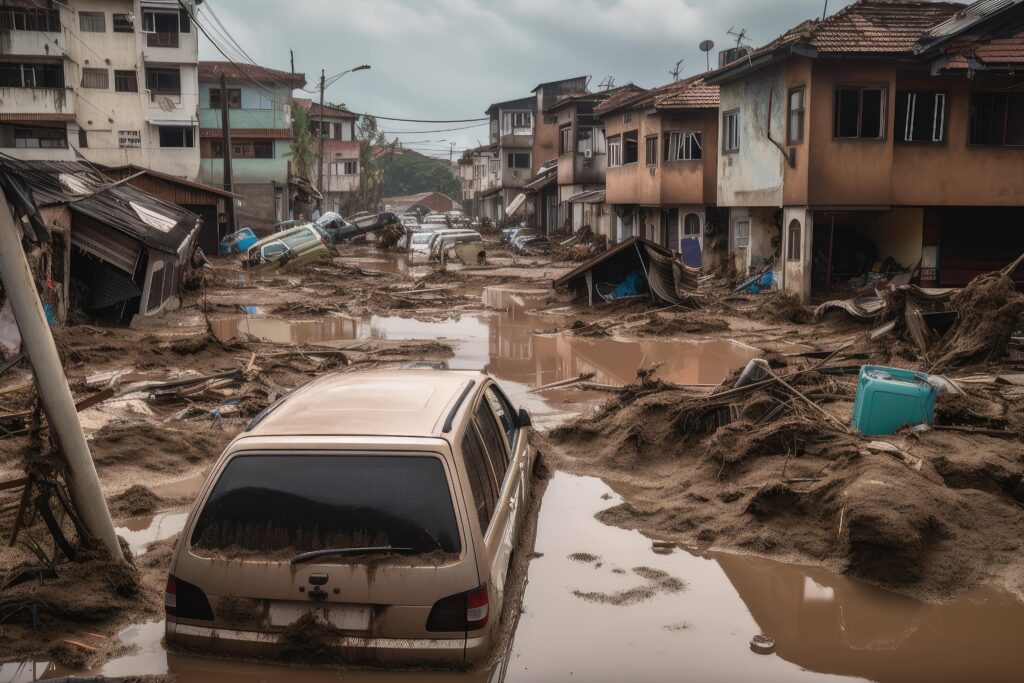
The coastal areas in the Tohoku Region were severely devastated by Tsunami in March 2011.
With this, a number of things, including houses, infrastructure as well as vehicles were damaged and left behind along the coastal areas.
These things needed to be treated as soon as possible, for the restoration of the affected areas.
With regard to the Countermeasure Areas for the Contaminated Waste, however, as aforementioned, the local municipalities, which could be main practitioners for the treatment of the waste, were forced to evacuate.
Therefore, the national government has been responsible for the treatment of the waste as one of the Waste in the Countermeasure Areas.
Waste generated by dismantling of affected houses

This is also mentioned above, but the Countermeasure Areas for the Contaminated Waste was designated based on the evacuation areas when the institution was established, so the residents were also forced to evacuate.
There were areas where temporary entry was admitted, but the affected residents have been remained for a long time as they were, and a number of affected houses faced no other choice but they needed to be dismantled.
For these houses the national government has become a main practitioner of the dismantling and waste generated through the dismantling has been treated as the Waste in the Countermeasure Areas.
Waste generated by clean-up activities

Shortly before the lift of evacuation order, usually there are terms for staying at home over nights, for the preparation to resume the new life of people smoothly.
The waste generated in the preparation term has also been treated as one of the Waste in the Countermeasure Areas.
The Designated Waste
Unlike the Waste in the Countermeasure Areas, the origin of the waste has nothing to do with the Designated Waste.
Therefore, the Designated Waste has been generated not only in the Fukushima Prefecture, but also in the wide range of areas, mainly from the Tohoku to the Kanto Regions.
The Designated Waste is defined in the Act on Special Measures concerning the Handling of Environment Pollution by Radioactive Materials, as the waste with radioactivity concentration with more than 8,000Bq/kg, with individual designation by the Minister of the Environment.
The value ‘8,000Bq/kg’ is derived from the dose assessment: among the treatment processes of the Designated Waste, the operation in a disposal site causes the highest dose to workers.
Even under this operation, the highest radioactivity concentration of the Designated Waste, which causes dose less than 1mSv/y to the worker, was estimated as 8,000Bq/kg.
The specific examples of the Designated Waste are shown in the following chapters.
Incineration ash
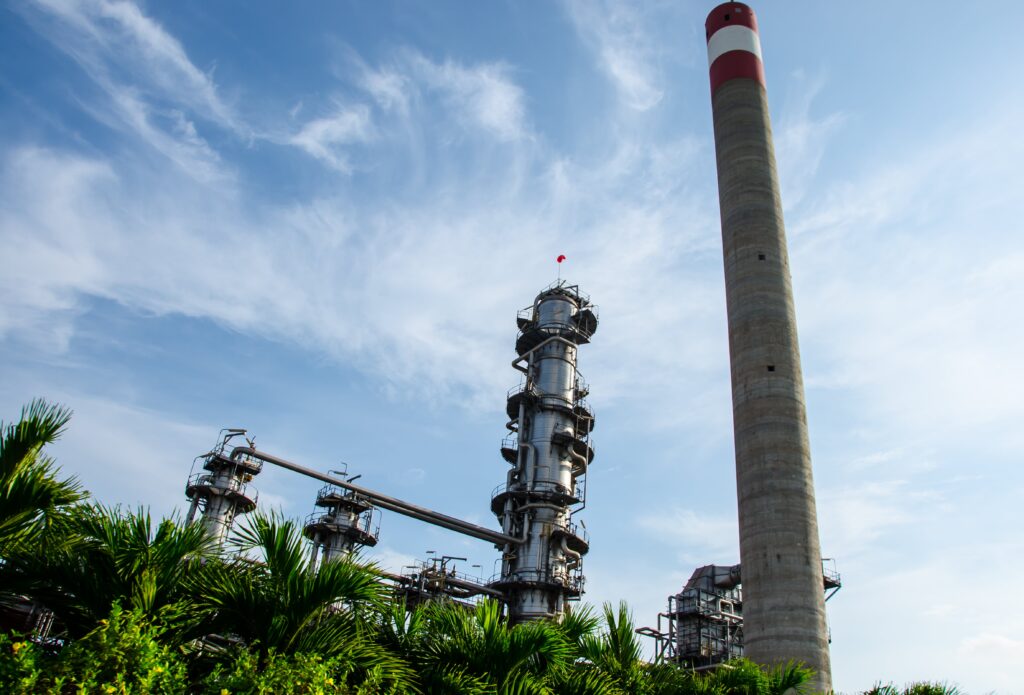
During the process of incineration, the volume of burnable waste is significantly reduced.
As a result of that, radioactive material is concentrated and radioactivity concentration tends to become much higher.
Radioactivity concentration of waste sometimes becomes more than 8,000Bq/kg, a value for designation of the Designated Waste, even if its radioactivity concentration is comparatively low before the incineration.
Agriculture or forestry waste
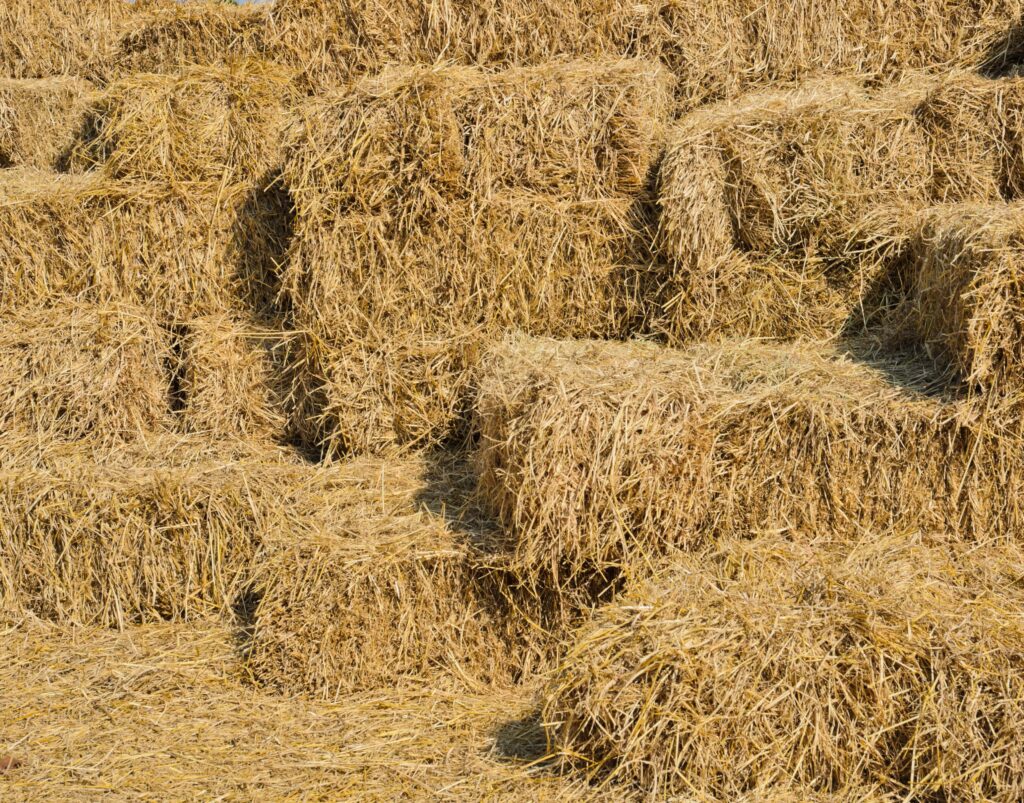
The agriculture or forestry waste mainly comprises of rice straw or compost.
After the accident, sometimes radioactive materials, falling from atmosphere are attached to the agriculture/forestry-related products.
Especially, with regard to products with small mass, like rice straw, sometimes its radioactivity concentration becomes more than 8,000Bq/kg, a value for designation of the Designated Waste, when calculating its radioactivity concentration.
Sewage sludge, water purification sludge

These are kinds of soil and sludge, generated through waste water treatment, or water purification processes.
Especially, radioceasium, one of the radioactive materials, which remains in the environment and affects the area for a long time after the accident of the nuclear power plant, has a characteristic to be firmly absorbed to soil particles.
It is concentrated during the waste water treatment or water purification processes, followed by further concentration during the dehydration process and its radioactivity concentration becomes higher than 8,000Bq/kg, a value for designation of the Designated Waste.
Please see this article regarding the radionuclides released into the environment due to the accident of the Fukushima Daiichi Nuclear Power Plant.
Summary
This article covers the waste arising from other than the decontamination activities, especially focusing on the Specified Waste (the Waste in the Countermeasure Areas and the Designated Waste).
To make the long story short, the Waste in the Countermeasure Areas is the waste generated within the Countermeasure Areas for the Contaminated Waste, and the Designated Waste is the waste with more than 8,000Bq/kg of radioactivity and designated individually by the Minister of the Environment.
By the way, abovementioned contents are summarized in the following videos.
It would be appreciated to visit them at your convenience.
– Japanese version
– English version
You can read the same article in Japanese here.
Thank you very much for reading this article.
See you next time!



コメント